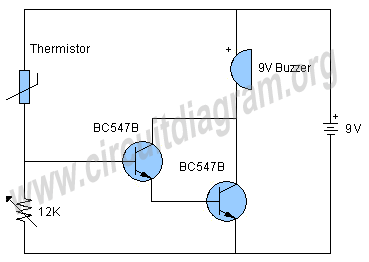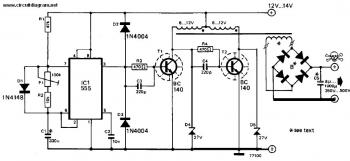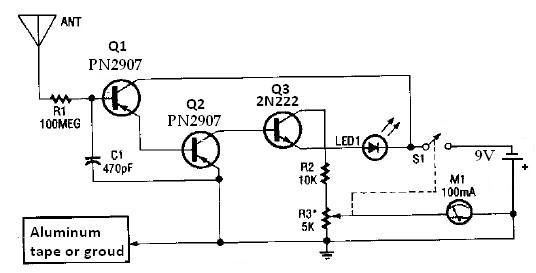
temperature alarm circuit

Transistors are configured as a Darlington pair in this circuit. A thermistor is utilized to detect or sense heat. A 12K variable resistor is employed to adjust the activation of the buzzer at the desired temperature. The operation of the circuit is straightforward; when the thermistor senses an increase in temperature, its resistance decreases, causing the transistors to switch on and activate the buzzer.
The circuit employs a Darlington pair configuration, which consists of two transistors connected in such a way that the current amplified by the first transistor is fed into the second transistor. This arrangement provides a high current gain, making it suitable for applications where a small input current needs to control a larger output current. The thermistor, a type of temperature-sensitive resistor, is placed in a voltage divider configuration with the variable resistor. As the temperature rises, the resistance of the thermistor decreases, which alters the voltage across it.
The 12K variable resistor allows for fine-tuning of the threshold temperature at which the circuit activates the buzzer. By adjusting this resistor, the user can set the desired temperature level that triggers the alarm. When the thermistor detects a temperature above this threshold, the resulting change in resistance will lead to an increase in base current for the Darlington pair. This causes the transistors to turn on, allowing current to flow through the buzzer, thus activating it.
In summary, this circuit efficiently combines a Darlington pair of transistors with a thermistor and a variable resistor to create a temperature-sensitive alarm system. The design ensures that the buzzer is only activated when the temperature exceeds a set level, providing a reliable means of monitoring temperature changes.transistors as a darlington pair. The circuit is also using a thermistor to detect or sense the heat. A 12K variable resistor is used to adjust the activation of the buzzer on the desired temperature. Working of the circuit is simple when the thermistor will sense temperature or heat its resistance will become lower due to which the transistors be come switch on and activate the buzzer. 🔗 External reference
The circuit employs a Darlington pair configuration, which consists of two transistors connected in such a way that the current amplified by the first transistor is fed into the second transistor. This arrangement provides a high current gain, making it suitable for applications where a small input current needs to control a larger output current. The thermistor, a type of temperature-sensitive resistor, is placed in a voltage divider configuration with the variable resistor. As the temperature rises, the resistance of the thermistor decreases, which alters the voltage across it.
The 12K variable resistor allows for fine-tuning of the threshold temperature at which the circuit activates the buzzer. By adjusting this resistor, the user can set the desired temperature level that triggers the alarm. When the thermistor detects a temperature above this threshold, the resulting change in resistance will lead to an increase in base current for the Darlington pair. This causes the transistors to turn on, allowing current to flow through the buzzer, thus activating it.
In summary, this circuit efficiently combines a Darlington pair of transistors with a thermistor and a variable resistor to create a temperature-sensitive alarm system. The design ensures that the buzzer is only activated when the temperature exceeds a set level, providing a reliable means of monitoring temperature changes.transistors as a darlington pair. The circuit is also using a thermistor to detect or sense the heat. A 12K variable resistor is used to adjust the activation of the buzzer on the desired temperature. Working of the circuit is simple when the thermistor will sense temperature or heat its resistance will become lower due to which the transistors be come switch on and activate the buzzer. 🔗 External reference
Warning: include(partials/cookie-banner.php): Failed to open stream: Permission denied in /var/www/html/nextgr/view-circuit.php on line 713
Warning: include(): Failed opening 'partials/cookie-banner.php' for inclusion (include_path='.:/usr/share/php') in /var/www/html/nextgr/view-circuit.php on line 713





